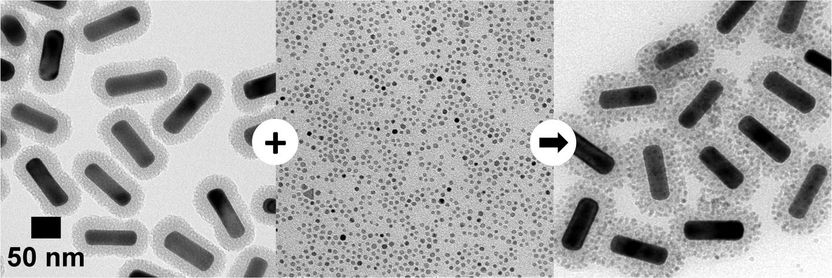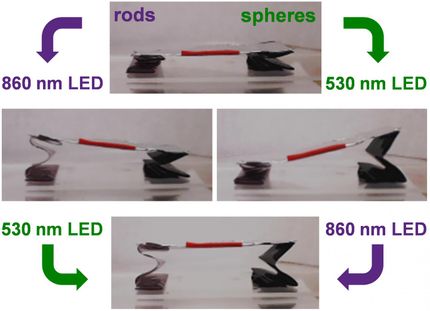A simpler way to deposit magnetic iron oxide onto gold nanorods
Advertisement
Researchers from North Carolina State University and MIT have found a simpler way to deposit magnetic iron oxide (magnetite) nanoparticles onto silica-coated gold nanorods, creating multifunctional nanoparticles with useful magnetic and optical properties.

Mixing silica-overcoated gold nanorods (left) and iron oxide nanoparticles (center) yields iron oxide-overcoated gold nanorods (right).
Brian Chapman
Gold nanorods have widespread potential applications because they have a surface plasmon resonance - meaning they can absorb and scatter light. And by controlling the dimensions of the nanorods, specifically their aspect ratio (or length divided by diameter), the wavelength of the absorbed light can be controlled. This characteristic makes gold nanorods attractive for use in catalysis, security materials and a host of biomedical applications, such as diagnostics, imaging, and cancer therapy. The fact that the magnetite-gold nanoparticles can also be manipulated using a magnetic field enhances their potential usefulness for biomedical applications, such as diagnostic tools or photothermal therapeutics.
"The approach we outline in our new paper is simple, likely making it faster and less expensive than current techniques for creating these nanoparticles - on a small scale or a large one," says Joe Tracy, an associate professor of materials science and engineering at NC State and corresponding author of a paper on the work.
The new technique uses an approach called heteroaggregation. Silica-coated gold nanorods are dispersed in ethanol, a polar solvent. In ethanol, the hydrogen atoms are partially positively charged, and the oxygen atoms are partially negatively charged. The magnetite nanoparticles are dispersed in hexanes, a non-polar solvent, where the charges are not separated. When the two solutions are mixed, the magnetite nanoparticles bind to the gold nanorods - and the resulting magnetite-gold nanoparticles are removed from the solvent using a simple centrifugation process.
"We are able to take pre-synthesized, silica-coated gold nanorods and iron oxide nanoparticles and then combine them," says Brian Chapman, a Ph.D. student at NC State and lead author of the paper. "This is simpler than other techniques, which rely on either growing iron oxide nanoparticles on gold nanorods or using molecular cross-linkers to bind the iron to the silica coating of the nanorods."
"Our approach also results in highly uniform nanoparticles," Tracy says. "And by incorporating ligands called PEG-catechols, the resulting nanoparticles can be dispersed in water. This makes them more useful for biomedical applications.
"These are interesting, and potentially very useful, multifunctional nanoparticles," Tracy adds. "And hopefully this work will facilitate the development of applications that capitalize on them."



























































